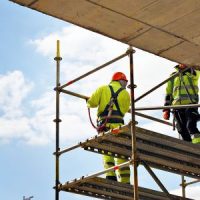Accidents Involving Scaffolding

Scaffolding is all around us, enabling workers on construction sites and maintenance workers to access hard-to-reach areas as they complete their work. But scaffolding is involved in far too many accidents that harm, or even kill workers. If you or a loved one has suffered a scaffolding accident that has resulted in serious consequences, an experienced personal injury attorney may bring you needed relief.
Scaffolding
Work platforms above ground give workers the ability to do their jobs in a particular area for a limited amount of time. There are three main types of scaffolding used on construction sites and elsewhere:
- Aerial and scissor lifts, which are machines that lift workers in a platform or bucket (commonly seen when maintenance is done on electrical poles);
- Suspended scaffolds, which are hung with cables from above (often seen being used by window washers);
- Supported scaffolds, which are platforms built on legs or frames and that stand on the ground (generally used in home and office building projects).
Who Uses Scaffolds?
Roughly two-thirds of construction workers throughout the country —over two million individuals– —have duties that require being on or around scaffolding. The categories of constructions workers who commonly use scaffolds include:
Designers of scaffolding;
Workers who are in charge of erecting and/or dismantling scaffolding;
Employees who do their jobs on scaffolding.
Scaffolding Accidents
The Bureau of Labor Statistics (BLS) reports that thousands of scaffolding accidents occur every year resulting in roughly 60 deaths exceeding 4,000 injuries annually. In addition to the physical and emotional toll this takes on employees and their families, these accidents result in nearly a billion dollars in lost workdays. The types of accidents involving scaffolding that occur most often include:
- Falls from scaffolding;
- Scaffolding that is unstable or that actually collapses;
- Objects falling and striking those below scaffolding;
- Electrocution.
Avoiding Common Accidents
It’s true that any construction site has a lot of moving parts, and it is impossible to anticipate and prepare for every possible accident. We do know, however, that when companies design and enforce basic safety precautions outlined by the Occupational Safety and Health Administration (OSHA), the number and severity of safety issues are quickly reduced. All employees absolutely must be properly trained in the language they understand. Only then will scaffolding dangers be mitigated, as companies adhere to common sense safety protocols:
- Requiring that approved safety harnesses are provided for anyone above ground level, in addition to having adequate toe-boards, hole covers, and guardrails, to reduce the chance of falls;
- Using exacting standards when building scaffolds and refraining from overloading them;
- Enforcing protocols for the handling of debris, tools, and work materials;
- Providing safety nets below scaffolding to protect workers below;
- Maintaining a safe distance from power lines.
After an Accident
If you or a family member has incurred serious injuries or death as a result of an incident involving scaffolding, you may be staggered by the financial impact of the incident. Unfortunately, Workers’ Compensation provides only a fraction of the earnings you took home before your accident, but your bills keep coming in. In the event the accident was the result of negligence on the part of the construction company, you may be eligible to receive compensation from them to address medical bills, lost wages, and pain and suffering. You focus on healing: let the knowledgeable Baltimore personal injury attorneys at The Law Office of Hasson D. Barnes take care of the rest.

